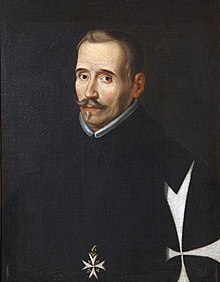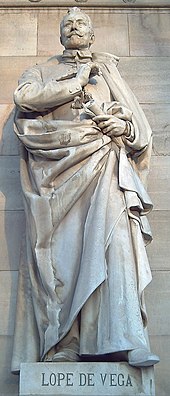Lope de Vega
Lope de Vega (born November 25, 1562 in Madrid , † August 27, 1635 there ; full name: Félix Lope de Vega Carpio ) was an important Spanish poet of the so-called Golden Age ( Spanish Siglo de Oro ).
Life
Lope de Vega was the son of a simple family who lived in the mountains of Cantabria . He was baptized on December 6, 1562 in San Miguel de los Octoes . He had four siblings: Francisco, Juliana, Luisa and Juan. He spent part of his childhood in the house of his uncle, the Inquisitor of Seville .
In 1574 he went to the Jesuit school in Madrid and a year later his comedy El verdadero amante appeared . In 1577 he began his studies at the University of Alcalá , which he finished in 1581. In 1579 Lope de Vega entered the service of Bishop Jerónimo Manrique , who probably helped him graduate from the University of Alcalá. In 1580 he fell in love with María de Aragón (Marfisa); their daughter Manuela was baptized on January 2, 1581. In 1583 he met Elena Osorio, the daughter of the artistic director Jerónimo Velázquez, for whom he wrote plays. Although Elena Osorio was married to Cristóbal Calderón, he began a love affair with her that lasted over four years, which resulted in an enmity with her father.
By the late 1980s, Lope de Vega was already a sought-after author, if not the most sought-after and best in Spain. In 1585 his daughter Manuela died. On December 29, 1587, Lope de Vega was arrested in the Corral de la Cruz during a performance because he had written a satire and a sonnet against Jerónimo Velázquez and his family, especially against his daughter Elena Osorio. In prison he continued to write slanderous letters and verses against Elena Osorio, so that on February 7, 1588 he was banished from the Kingdom of Castile for two years and from court for four years. The next day Lope de Vega left Madrid with Isabel de Urbina, whom he married on May 10 for tactical reasons .
The following time they lived in Valencia , where their first daughter Antonia was born. On May 29th, he volunteered in Lisbon on a ship of the Armada Invencible . After returning to Valencia, Lope de Vega was very active and wrote his work Primer florilegio de romances . Lope de Vega was secretary to the Duke of Alba from 1591 to 1595 . In 1594 his daughter Antonia and his wife Isabel von Urbina died giving birth to another daughter, Teodora, who also died two years later.
In 1595 Lope de Vega left the duke of Alba and returned to Madrid. There he was brought to justice in 1596 for the "wild marriage" he led with the widowed Antonia Trillo de Armenta . In the same year he met the actress Micaela Luján, with whom he had an affair a few years later. In 1598 Lope de Vega married Juana Guardo, the daughter of a rich fish and meat supplier, in the Iglesia de Santa Cruz in Madrid. This wedding was thoughtful, because Juana brought a large dowry into the marriage. From 1599 to 1607 Lope, still married, had an affair with Micaela Luján, with whom he lived in Seville , Granada , Toledo and Madrid. At least five of the nine children Micaela had were from Lope de Vega.
In 1607 he entered the service of Luis Fernando de Córdoba , initially as a "secret" secretary, later as secretary for political letters and love letters . The initially purely professional relationship, which lasted 28 years, turned into a true friendship. Two years later the work Arte Nuevo was published , in which he announces that he is very proud to have written 483 comedies. It was also in this work that he developed his ideas on dramatic art, in which natural beauty is the ideal of art.
In August 1613, Lope de Vegas' wife Juana Guardo died. In the spring of 1614 Lope de Vega was ordained a priest .
Lope de Vega died in 1635 in his house in Madrid, which was established in his honor in 1935 as the Casa Museo Lope de Vega .
The development of the Spanish drama under the influence of Lope de Vega
He shaped the classic form of the Comedia with three acts, changing meters and the figure of " Gracioso " (the hero's funny opponent). The main themes in his works are honor, love, patriotism and religion. Another important issue is family, which is often associated with honor. He created the " cloak and sword piece ", the folk drama in which the right of the people against the attacks of the nobility is emphasized, as well as mythological and shepherd plays . Of the presumably more than 1,500 comedias, around 500 have survived (the best known is The Judge of Zalamea in the adaptation of Calderón de la Barca ); also poems and novels. A very significant difference between the Italian Commedia and the Spanish Comedia is that the Italian is very much oriented towards the Greek and Latin Comedia, whereas the Spanish Comedia refers to the Spanish culture alone.
Works
- Program brochure Arte nuevo de hacer comedias (1609)
- The famous drama by Fuente Ovejuna ISBN 3-15-008884-4
- Shepherds of Bethlehem ISBN 3-458-33063-1
- El acero de Madrid
- Las almenas de Toro
- Al pasar del arroyo
- Los amantes sin amor
- Amar, servir y esperar
- Amar sin saber a quién
- El amigo hasta la muerte
- El amor enamorado
- Cupid, pleito y desafío
- Arauco domado por el Excelentísimo Señor Don García Hurtado de Mendoza
- Las aventuras de Don Juan de Alarcos
- Ay, verdades que en amor ...!
- Los bandos de Sena
- Las batuecas del Duque de Alba
- The principle of construction of Marruecos
- La bella aurora
- La bella malmaridada
- La boba para los otros y discreta para sí
- Los paces de los reyes y judía de Toledo (German: The reconciliation of the royal couple and the Jewish woman of Toledo ) (1610–1612)
- El perro del hortelano
- La viuda valenciana
- La vitoria de la honra
- La dama boba
reception
Lope de Vega was mentioned in the novel Buddenbrooks by Thomas Mann , published in 1901 , in which one of the characters, the real estate agent Sigismund Gosch, is working on a German translation of all of Lopes' dramas.
literature
- Eberhard Müller-Bochat: Lope de Vega and the Italian poetry (= treatises of the humanities and social science class of the Academy of Sciences and Literature in Mainz. Born 1956, No. 12).
Web links
- Literature by and about Lope de Vega in the catalog of the Ibero-American Institute in Berlin
- Literature by and about Lope de Vega in the catalog of the German National Library
- Works by and about Lope de Vega in the German Digital Library
- Literature by and about Lope de Vega in the catalog of the library of the Instituto Cervantes in Germany
- Contemporary German-language editions in VD 17
- Overview of the works of Lope de Vega in the original Spanish, with the possibility of purchase
- Full biography in Spanish and notes on the development of Spanish drama
- Detailed curriculum vitae, list of all works, pictures and other links
- Lope de Vega: Trezena Parte De Las Comedias De Lope De Vega Carpio, Procurador Fiscal de la Camara Apostolica en el Arçobispado de Toledo E-Book of the University Library Vienna ( eBooks on Demand ) of the edition of 1620 (Madrid, Viuda de Alonso Martín)
- Richter ... !, not avenger - Volume 006: Tragedy in three acts E-Book of the University Library Vienna ( eBooks on Demand )
- Works by Lope de Vega in the Gutenberg-DE project
Individual evidence
- ↑ Armada Invencible on mgar.net
- ↑ Arte Nuevo on cervantesvirtual.com
- ↑ Las almenas de Toro online at cervantesvirtual.com
- ↑ Al pasar del arroyo online at cervantesvirtual.com
- ↑ Los amantes sin amor online at cervantesvirtual.com
- ↑ Amar, servir y esperar online at cervantesvirtual.com
- ↑ Amar sin saber a quién online at cervantesvirtual.com
- ↑ El amor enamorado online at cervantesvirtual.com
- ↑ Amor, pleito y desafío online at cervantesvirtual.com
- ↑ Arauco domado por el Excelentísimo Señor Don García Hurtado de Mendoza online on cervantesvirtual.com
- ↑ Ay, verdades que en amor ...! online at cervantesvirtual.com
- ↑ Los bandos de Sena online at cervantesvirtual.com
- ↑ Las batuecas del Duque de Alba online at cervantesvirtual.com
- ↑ El bautismo del príncipe de Marruecos online at cervantesvirtual.com
- ↑ La bella Aurora online at cervantesvirtual.com
- ↑ La bella malmaridada online at cervantesvirtual.com
- ↑ La boba para los otros y discreta para sí online at cervantesvirtual.com
- ^ Harenberg Lexikon der Weltliteratur, 1994 study edition, ISBN 3-611-00338-7 , p. 2983
- ↑ El perro del hortelano online at cervantesvirtual.com
- ↑ La viuda valenciana online at cervantesvirtual.com
- ↑ La vitoria de la honra online at cervantesvirtual.com
- ↑ La dama boba online at cervantesvirtual.com
| personal data | |
|---|---|
| SURNAME | Vega, Lope de |
| ALTERNATIVE NAMES | Vega Carpio, Lope Félix de |
| BRIEF DESCRIPTION | Spanish poet |
| DATE OF BIRTH | November 25, 1562 |
| PLACE OF BIRTH | Madrid |
| DATE OF DEATH | August 27, 1635 |
| Place of death | Madrid |

